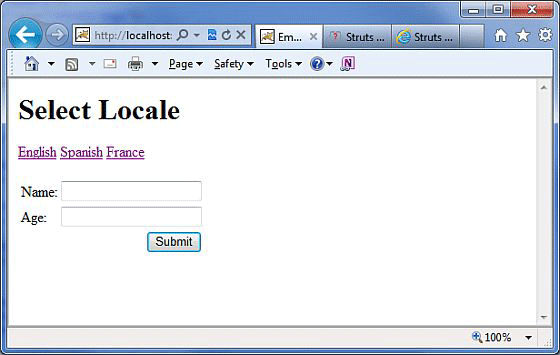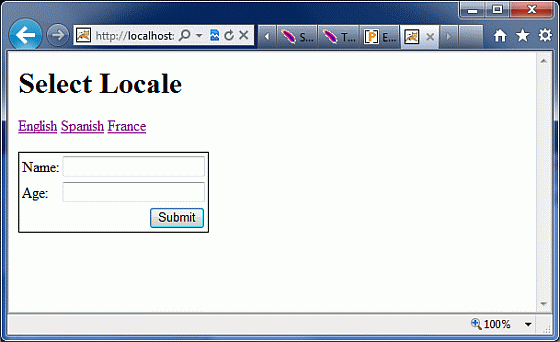- Struts 2配置文件-struts.xml(1)
- Struts 2配置文件-struts.xml
- Struts 2教程
- Struts 2教程(1)
- 主题 (1)
- 讨论Struts 2(1)
- 讨论Struts 2
- Struts 2-概述
- Struts 2-概述(1)
- Struts 2-注释
- Struts 2-注释(1)
- struts 2注释示例
- struts 2注释示例(1)
- Java的Spring 与 Struts(1)
- Java的Spring 与 Struts
- C++模板
- 模板 (1)
- C++模板
- C++模板(1)
- c++ 模板 - C++ (1)
- C++中的模板(1)
- 模板的模板 c++ (1)
- C++模板(1)
- c# 模板 - C# (1)
- C++模板
- C++中的模板
- 模板 c++ (1)
- Struts 2-数据标签
- Struts 2-数据标签(1)
📅 最后修改于: 2020-11-11 05:03:24 🧑 作者: Mango
在开始本章的实际教程之前,让我们研究一下https://struts.apache.org给出的一些定义-
| Sr.No | Term & Description |
|---|---|
| 1 |
TAG A small piece of code executed from within JSP, FreeMarker, or Velocity. |
| 2 |
TEMPLATE A bit of code, usually written in FreeMarker, that can be rendered by certain tags (HTML tags). |
| 3 |
THEME A collection of templates packaged together to provide common functionality. |
我也建议您仔细阅读《 Struts2本地化》一章,因为我们将再次以相同的示例进行练习。
当您在网页中使用诸如
| Sr.No | Theme & Description |
|---|---|
| 1 |
SIMPLE theme A minimal theme with no “bells and whistles”. For example, the textfield tag renders the HTML tag without a label, validation, error reporting, or any other formatting or functionality. |
| 2 |
XHTML theme This is the default theme used by Struts 2 and provides all the basics that the simple theme provides and adds several features like standard two-column table layout for the HTML, Labels for each of the HTML, Validation and error reporting etc. |
| 3 |
CSS_XHTML theme This theme provides all the basics that the simple theme provides and adds several features like standard two-column CSS-based layout, using for the HTML Struts Tags, Labels for each of the HTML Struts Tags, placed according to the CSS stylesheet.
|
如上所述,如果您未指定主题,则Struts 2将默认使用xhtml主题。例如,此Struts 2选择标签-
生成以下HTML标记-
此处的empinfo是struts.xml文件中定义的操作名称。
选择主题
您可以根据Struts 2的标签指定主题,也可以使用以下方法之一指定Struts 2应该使用的主题-
-
特定标签上的主题属性
-
标签周围表单标签上的主题属性
-
页面范围的属性名为“主题”
-
请求范围的属性名为“主题”
-
会话范围的属性名为“主题”
-
应用程序范围内的属性名为“主题”
-
struts.properties中的struts.ui.theme属性(默认为xhtml)
如果您愿意对不同的标签使用不同的主题,则以下是在标签级别指定它们的语法-
因为在每个标签上使用主题不是很实际,所以我们可以简单地使用以下标签在struts.properties文件中指定规则-
# Standard UI theme
struts.ui.theme = xhtml
# Directory where theme template resides
struts.ui.templateDir = template
# Sets the default template type. Either ftl, vm, or jsp
struts.ui.templateSuffix = ftl
以下是我们从本地化一章获得的结果,在本地化一章中,我们在struts-default.properties文件中使用了默认主题,并将其设置为struts.ui.theme = xhtml ,默认情况下位于struts2-core.xy.z.jar文件中。

主题如何运作?
对于给定的主题,每个struts标记都有一个关联的模板,例如s:textfield→text.ftl和s:password→password.ftl等。
这些模板文件压缩在struts2-core.xy.z.jar文件中。这些模板文件为每个标签保留了预定义的HTML布局。
这样, Struts 2框架使用Sturts标记和关联的模板生成最终的HTML标记代码。
Struts 2 tags + Associated template file = Final HTML markup code.
默认模板是用FreeMarker编写的,扩展名为.ftl 。
您也可以使用Velocity或JSP设计模板,并相应地使用struts.ui.templateSuffix和struts.ui.templateDir在struts.properties中设置配置。
创建新主题
创建新主题的最简单方法是复制任何现有主题/模板文件并进行所需的修改。
让我们从在WebContent / WEBINF / classes中创建一个名为template的文件夹以及一个带有新主题名称的子文件夹开始。例如, WebContent / WEB-INF / classes / template / mytheme 。
从这里开始,您可以从头开始构建模板,也可以从Struts2发行版中复制模板,以后可以根据需要对其进行修改。
为了学习目的,我们将修改现有的默认模板xhtml 。现在,让我们将内容从struts2-core-xyzjar / template / xhtml复制到我们的主题目录,并仅修改WebContent / WEBINF / classes / template / mytheme / control .ftl文件。当我们打开control.ftl时,将有以下几行-
style="${parameters.cssStyle?html}"
#if>
>
让我们将文件control.ftl更改为以下内容-
如果要检查form.ftl ,则会发现该文件中使用了control.ftl ,但是form.ftl从xhtml主题引用了此文件。因此,让我们如下进行更改-
onreset = "${parameters.onreset?default('clearErrorMessages(this);\
clearErrorLabels(this);')}"
onreset="${parameters.onreset?html}"
#if>
#if>
#include "/${parameters.templateDir}/mytheme/control.ftl" />
我认为,您对FreeMarker模板语言不会有太多的了解,但是您仍然可以通过查看.ftl文件来很好地了解要做什么。
但是,让我们保存以上更改,然后返回到本地化示例并使用以下内容创建WebContent / WEB-INF / classes / struts.properties文件
# Customized them
struts.ui.theme = mytheme
# Directory where theme template resides
struts.ui.templateDir = template
# Sets the template type to ftl.
struts.ui.templateSuffix = ftl
现在,在进行此更改之后,右键单击项目名称,然后单击“导出”>“ WAR文件”以创建War文件。然后,将此WAR部署在Tomcat的webapps目录中。最后,启动Tomcat服务器并尝试访问URL http:// localhost:8080 / HelloWorldStruts2 。这将产生以下屏幕-

您可以看到表单组件周围的边框,这是我们从xhtml主题复制出来后在out主题中所做的更改的结果。如果您不花力气学习FreeMarker,那么您将可以非常轻松地创建或修改主题。
我希望现在您对Sturts 2主题和模板有了基本的了解,不是吗?